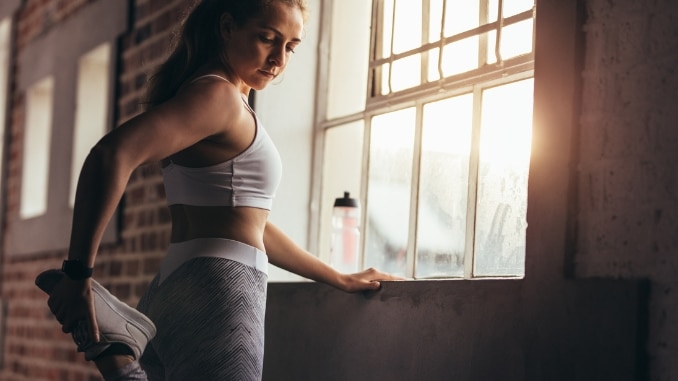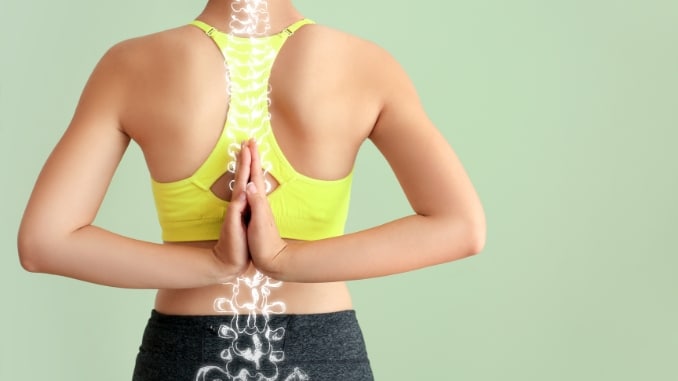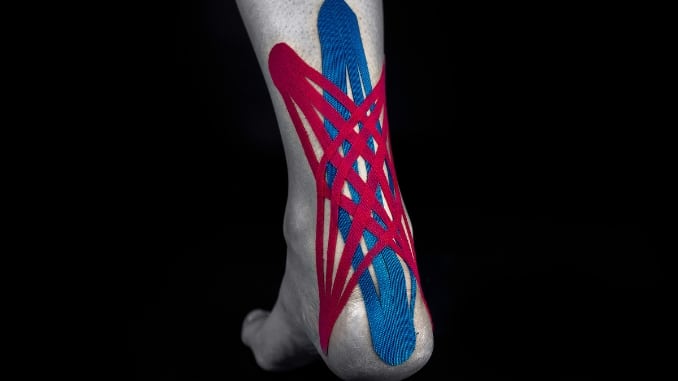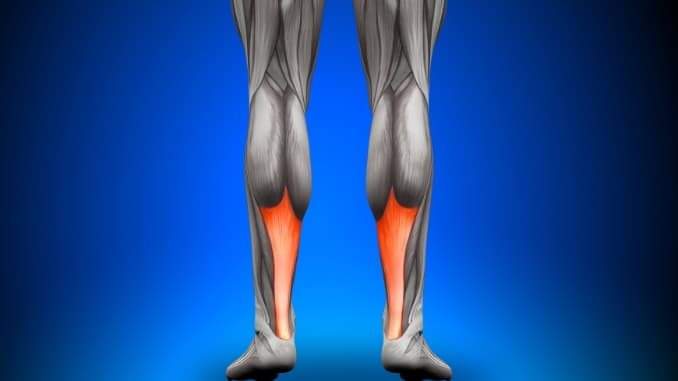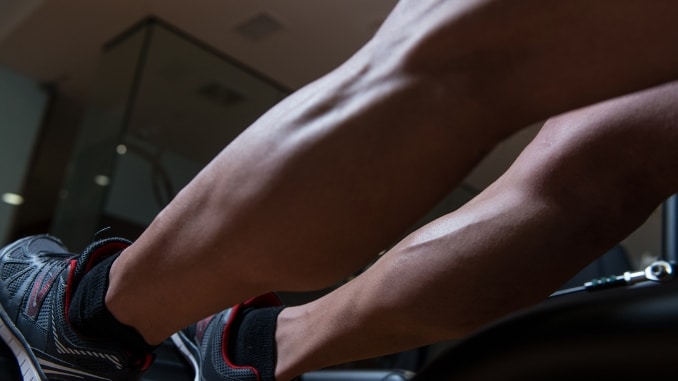“Strong calves lead to strong legs, and strong legs lead to a strong body.”
Calf stretches enhance the flexibility of the muscles and tendons in your calves. This increased flexibility contributes to a greater range of motion in your ankle and foot joints. Calf stretches are crucial for maintaining flexible, resilient lower limbs. Incorporating these stretches into your routine enhances muscle and tendon flexibility, fostering a broader range of motion in ankle and foot joints.
Calf stretches improve circulation, reduce muscle soreness, and contribute to better posture. Whether you’re an athlete or simply prioritizing your well-being, these stretches are a small yet powerful investment in ensuring your calves remain supple, strong, and ready for the demands of daily life.
Benefits of Calf Stretches
Here are the following benefits you can get from doing calf stretches:
1. Flexibility and Range of Motion
Calf stretches enhance the flexibility of the muscles and tendons in your calves. This increased flexibility contributes to a greater range of motion in your ankle and foot joints.
2. Injury Prevention
Tight calf muscles can cause problems, including Achilles tendinitis (inflammation of the tendons), shin splints, and muscular strains. Regular calf stretches can help lessen the risk of these ailments by keeping the muscles supple and less prone to overuse.
3. Improved Circulation
Stretching promotes better blood circulation. By stretching your calf muscles, you enhance blood flow to the lower extremities, contributing to better cardiovascular wellness and assisting in recovery after physical activity.
A study by Mevada et al. (2024) explored the effects of calf muscle stretching and foam rolling[1] on blood pressure. Participants performed calf stretches using a TheraBand and self-myofascial release with a foam roller. Both methods effectively reduced systolic and diastolic blood pressure immediately, with active stretching showing slightly better results than foam rolling. This suggests that regular calf muscle stretching can be beneficial for managing blood pressure in individuals with high normal values.
4. Reduced Muscle Soreness
Your calf muscles may tighten after a strenuous workout or physical activity. Stretching relieves muscular discomfort by encouraging tension release and improving blood flow, resulting in a faster recovery.
5. Better Posture and Alignment
Tight calves can affect your posture and gait. Regular stretching helps maintain proper alignment and balance, reducing the likelihood of developing musculoskeletal issues.
6. Enhanced Athletic Performance
Tight calf muscles are essential for many physical activities, including running, jumping, and cycling. Enhanced flexibility may result in superior athletic performance and increased agility.
7. Prevention of Plantar Fasciitis
Calf stretches can indirectly benefit the plantar fascia, the tissue that connects the bottom of the foot. Tight calf muscles can increase the likelihood of developing plantar fasciitis, a frequent culprit behind heel pain. Calf stretching alleviates pain[2], enhances range of motion and muscle strength, and improves functional outcomes in individuals suffering from plantar fasciitis.
8. Joint Health
Calf stretches target the muscles and promotes the health of the ankle and knee joints. This is particularly important for individuals who engage in activities that stress these joints.
Incorporating calf stretches into your routine, especially before and after exercise, can go a long way in maintaining the health and functionality of your lower limbs. So, stretch it out and keep those calves happy!
Anatomy of the Calf Muscles
1. Gastrocnemius Muscle
This is the more prominent of the two calf muscles and forms the building shape often associated with strong, defined calves. It has two heads, or muscle bellies, originating above the knee joint to form the Achilles tendon.
2. Soleus
The soleus, situated beneath the gastrocnemius, is a flat muscle that originates from the tibia and fibula bones. It contributes to the Achilles tendon and plays a crucial role in activities like walking and standing.
3. Achilles Tendon
The Achilles tendon is the body’s most substantial and resilient tendon. It serves tissue bridge linking the gastrocnemius and soleus muscles to the heel bone, the calcaneus. It facilitates movements like pointing the foot and pushing off the ground.
The Achilles tendon collaborates with the calf muscles to execute various movements seamlessly. These include plantar flexion (pointing the foot downward), a crucial movement for walking, running, and jumping. Additionally, the calf muscles notably influence the stabilization of the ankle and knee joints.
Flex and Flow: Your Ultimate Guide to the 5 Best Calf Stretches
Calf stretches are crucial for maintaining flexibility and preventing injuries. Here are seven effective calf stretches you can try:
1. Standing Calf Stretch
For this exercise, utilize the wall for support if needed.
Begin in an upright standing position with your hands against the wall. Take a big step back with your right foot, keeping your toes pointing straight ahead and your heels flat on the floor. Bend your front knee while keeping your back leg straight. Maintain good alignment with your head, shoulders, and hips while keeping your left leg bent. Hold this position for several deep belly breaths, in through your nose and out through your mouth. Return to the starting position and repeat the movement on the opposite side.
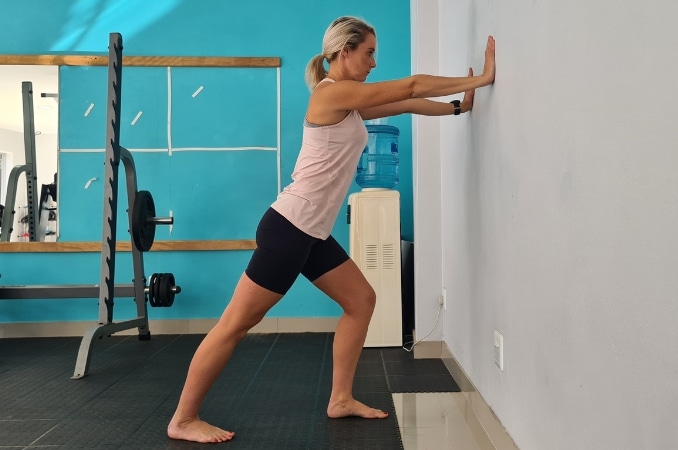
2. Seated Calf Stretch
For this exercise, utilize a towel, belt, resistance band, or anything you can loop your feet around for added resistance.
Begin in an upright sitting position with your legs extended in front of you, maintaining good alignment with your head, shoulder, and hips. Loop a towel around your feet and hold each end with your hand. Engage your core. Looking for a gentle stretch on the back of your legs, slowly lean your upper body back, creating resistance on the towel. Hold the position for several deep belly breaths, in through your nose and out through your mouth. Relax and return to the starting position.
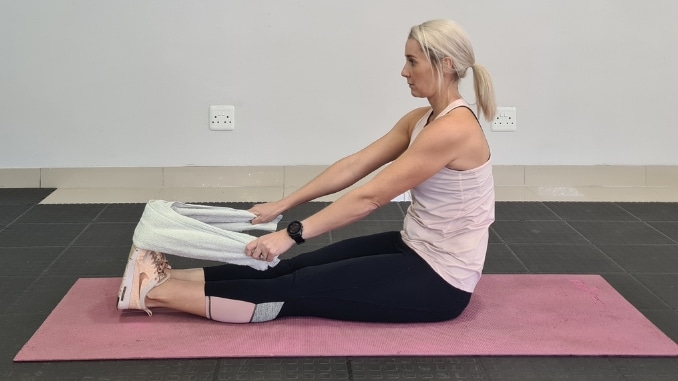
3. Downward-Facing Dog
Move into a 4-point position with your knees below your hips and your hands beneath your shoulder. Tighten your abdominal muscles and push back with your arms, straightening your legs as you lift your hips. Hold this position for several deep belly breaths, in through your nose and out through your mouth.
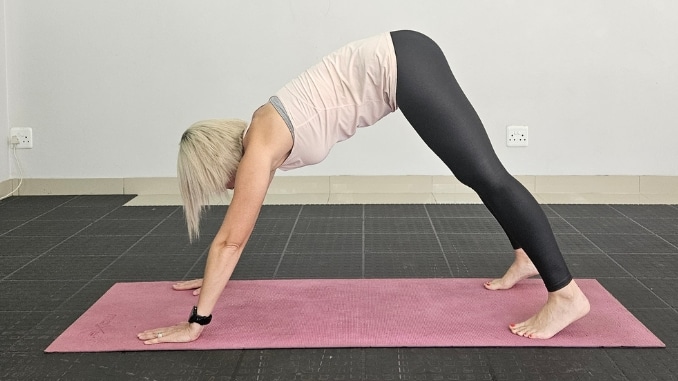
4. Bent Knee Calf Raises
For this exercise, use an aerobic stepper, plyometric box, the bottom step of the stairs, or any other stable elevated surface.
Stand upright on the edge of the aerobic stepper or the bottom step of your stairs. Hold onto the back of a chair or wall for balance and support. Engage your core. Bend both knees and raise to your toes on both feet, maintaining good alignment with your head, shoulders, and hips. Hold this position for a couple of seconds. Lower your heels back down to return to the starting position. Repeat the movement as needed.
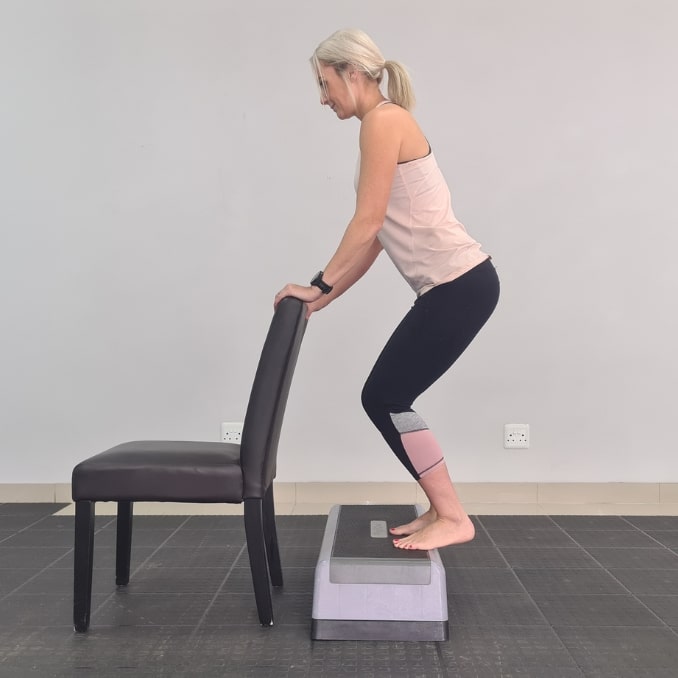 |
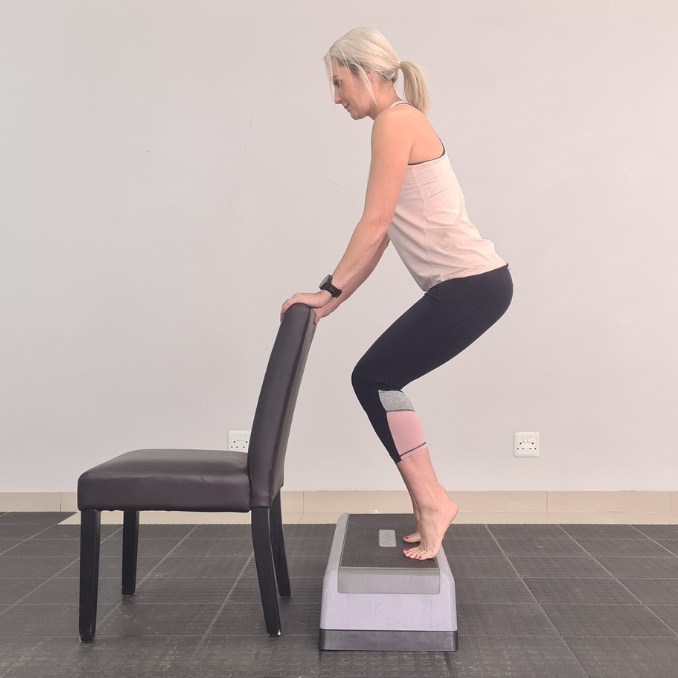 |
5. Step Ups
For this exercise, use an aerobic stepper, plyometric box, the bottom step of the stairs, or any other stable elevated surface.
Begin in an upright standing position in front of an aerobic stepper with your feet hip-width apart, maintaining good alignment with your head, shoulders, hips, and legs. Place your arms at your sides and engage your core. Step one foot on the aerobic stepper, followed by your other foot, countering each stepping movement with your opposite arm. Leading with the last foot up, step back down to return to the starting position. Repeat the movement on the opposite leg.
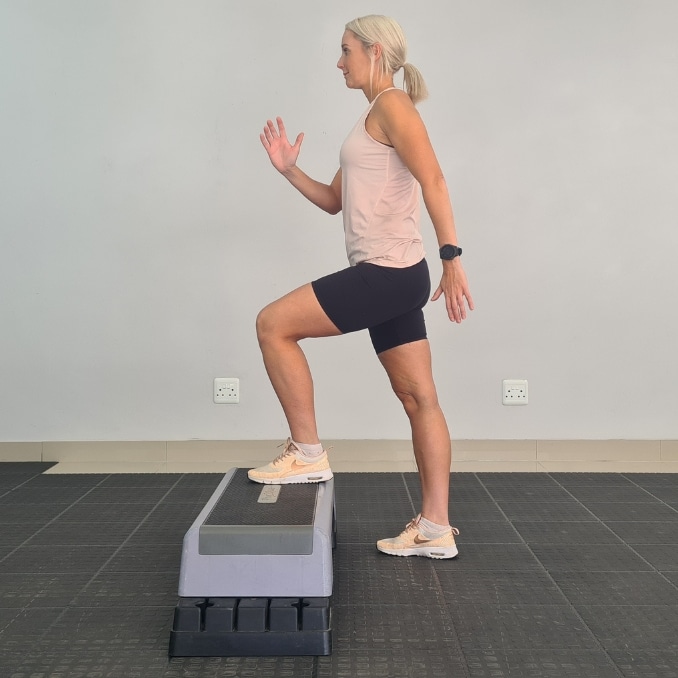 |
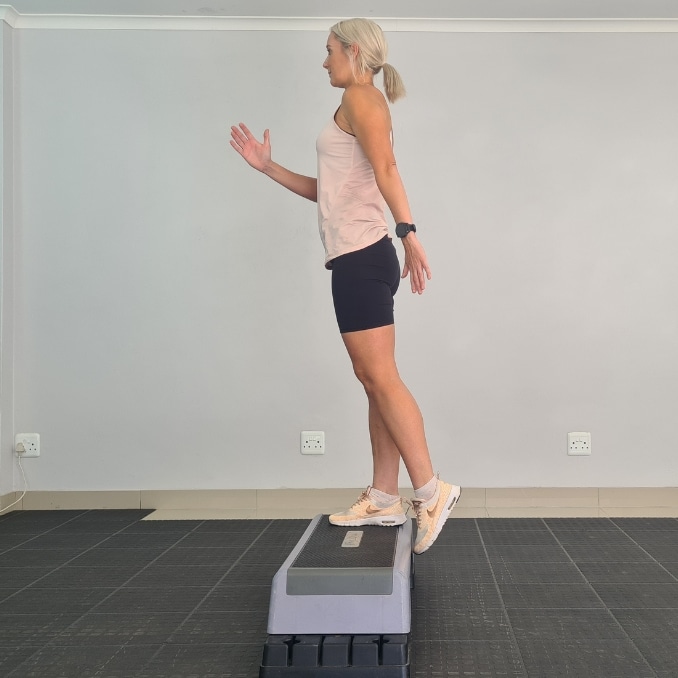 |
Calf Care 101: Mastering the Art of Effective Stretching
Stretching your calves really well is super important for keeping your legs healthy. It helps you bend and move better, which is important for doing everyday stuff and sports. Doing these stretches often helps stop problems like Achilles tendonitis and muscle strains.
1. Consistency is Key
Make calf stretches a regular part of your routine. Consistent stretching improves flexibility over time.
2. Warm Up First
Always warm up your muscles before stretching. Cold muscles tend to be less flexible and are at a higher risk of injury.
3. Hold Don’t Bounce
Hold each stretch for 15-30 seconds. Avoid bouncing, as it can lead to micro-tears and increased injury risk. The article from Mayo Clinic advises against bouncing during stretches, holding stretches for about 30 seconds, and incorporating movement into stretching routines[3], like dynamic warmups or exercises such as tai chi, Pilates, or yoga. Regular stretching is recommended to maintain benefits, and individuals with chronic conditions or injuries should consult healthcare professionals for tailored advice.
4. Listen to your body
Pay attention to your body’s signals. Stretch to the point of tension, not pain. If it hurts, ease off the stretch. Discomfort during stretching is normal, but sharp or intense pain is not. If you feel pain, ease off the stretch to prevent injury.
5. Include Dynamic Stretches
Before intense physical activity, incorporate dynamic calf stretches. These involve movement to warm up muscles and joints.
6. Variety Matters
Include different calf stretches in your routine. This ensures you target various muscles and angles.
7. Combine with Strengthening
Strengthening exercises like calf raises complement stretching. The combination improves overall calf health and function.
8. Medical Conditions
If you have existing medical conditions or injuries, consult a healthcare professional or a physical therapist before starting a new stretching routine.
9. Proper Technique
Pay attention to proper technique. Incorrect form can lead to ineffective stretches or even injury. More is not always better. Overstretching can lead to muscle strains or other injuries. Focus on a gentle and gradual stretch.
The Mayo Clinic emphasizes the significance of stretching to enhance flexibility and range of motion, thereby boosting physical performance and reducing the likelihood of injuries. However, it emphasizes proper stretching techniques to avoid potential harm.
Key tips include warming up before stretching to prevent injury to cold muscles, avoiding pre-event stretching for certain activities that could reduce performance or strength, and focusing on major muscle groups and symmetry to ensure balanced flexibility.
Conclusion
In summary, adding calf stretches to your exercise routine does more than just improve flexibility—it’s crucial for overall muscle and joint health, especially for the calf muscles, ankles, and lower legs. This helps prevent calf strains and supports your well-being. Regular calf stretches, like single-leg raises, strengthen muscles, reducing the risk of strains and aiding in faster recovery. Embracing calf stretches promotes joint health, prevents imbalances, and supports good posture, whether you’re an athlete or just aiming for a healthier lifestyle. So, stretch those calves, enjoy the benefits, and keep your muscles happy and healthy.
It is important to follow a carefully designed program that is guaranteed to loosen your tight calves safely. So check out this 10 Easy Movements to Loosen Tight Calves now!

